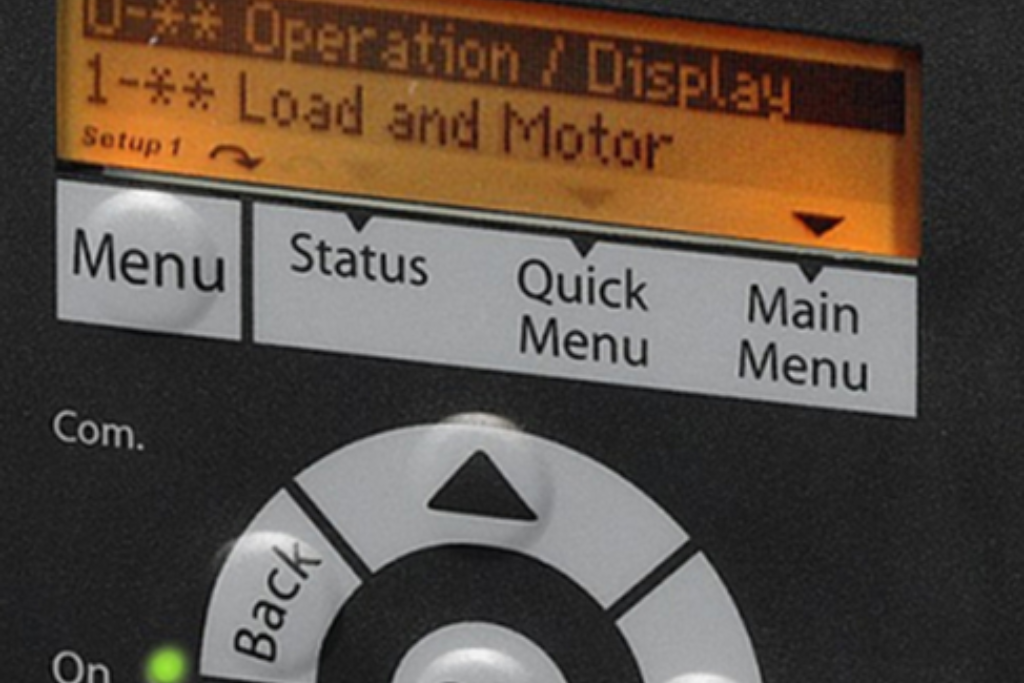Variable Speed Drives (VSDs) are a natural progression of the evolution of industrial processes and demand for more efficient and adaptable machinery. In the dynamic landscape of modern manufacturing, where precision, energy optimisation, and process flexibility are paramount, conventional fixed-speed operation of electric motors no longer suffices. The inception of the Variable Speed Drive (VSD) concept stems from the imperative to fine-tune the speed and torque of electric motors to match the requirements of diverse industrial applications. Factors such as energy conservation, enhanced productivity, and reduced mechanical stress on equipment have collectively fuelled the innovation and development of Variable Speed Drives, heralding a new era of intelligent and adaptive motor control technology.
What is a variable speed drive (VSD)?
A Variable Speed Drive (VSD) is a sophisticated electronic device designed to control and adjust the speed, torque, and power output of electric motors. It achieves this by manipulating the frequency and voltage of the electrical power supplied to the motor. Unlike traditional fixed-speed motors, which operate at a constant speed determined by the power source frequency, VSDs offer the ability to alter the motor’s speed in real-time, allowing for optimal performance in various industrial applications.
The fundamental idea behind Variable Speed Drives is to offer precise control over motor-driven machinery to match the specific requirements of a process. VSDs allow for seamless adjustment of motor speeds, ensuring that equipment operates efficiently under changing conditions, resulting in energy savings, reduced wear and tear, and enhanced productivity.
By altering the frequency and voltage supplied to the motor, a VSD enables the motor to operate at different speeds while maintaining the desired torque level. This level of control has far-reaching benefits in various industries, from manufacturing and HVAC (heating, ventilation, and air conditioning) systems to pumping, conveyors, and even elevators.
VSDs, to a large extent, have eliminated the conventional fixed speed electrical starter panels from the Industry.
Advantages of Variable Speed Drives in Process Control
There are numerous and significant benefits of employing variable speed drive units in process control. They enable smoother, precise and more controlled operation, adjustable acceleration, and the ability to adapt to different operating speeds for various processes. They also compensate for changes in process variables, facilitate slow operations for setup purposes, and offer control over production rates and accurate positioning. Additionally, the real time response to feedback that VSDs allow for controlling torque or tension, contribute to substantial energy and time savings.
Optimising Energy Efficiency with Variable Speed Drive Units
A key highlight of variable speed drives is their exceptional capability to markedly decrease energy consumption. Conventional electric motors are known to consume considerable quantities of energy, a concern that variable-speed drives adeptly address. By incorporating variable speed drives to regulate motor speed, the power expenditure can be notably curbed —this intelligent modulation of motor speed results in optimal energy usage.
Furthermore, adopting variable speed drives also translates into augmented production efficiency. This arises from the precise control they offer over motor speed, which not only minimises errors but significantly bolsters overall output and subsequent profitability. The dynamic nature of variable speed drive units cultivates smoother operational sequences, further contributing to their impact. This enhanced operational smoothness culminates in extended lifespans for machinery and a reduced need for maintenance, underlining the comprehensive advantages these drive units offer.
Components and Operation of Variable Speed Drives
A typical variable speed drive comprises essential components, including a rectifier to convert incoming AC power into DC power, a DC bus with capacitors for energy storage and smoothing output voltage, an inverter to convert DC power back into variable-frequency AC power, and a controller or regulator for precise control operations. Variable speed drive units transform the fixed-frequency input supply into a variable-frequency output, enabling the motor to operate at different speeds. By adjusting the motor’s output torque based on requirements, variable speed drives can rotate large loads at slow speeds or lighter loads at higher speeds.
Operation
- Variable speed drive units receive fixed-frequency input supply.
- Rectifier converts AC power into DC power.
- DC bus stores energy and smooths output voltage.
- Inverter transforms DC power back into variable-frequency AC power.
- Controller/regulator offers precise control over the motor.
Benefits
- Enables operation at different speeds.
- Adjusts output torque for varying requirements.
- Optimises energy consumption and efficiency.
- Extends motor lifespan through controlled operation.
- Enables smooth start-ups and adjustments.
- Adapts to different load demands effectively.
Types of Variable Speed Drives for Diverse Applications
There are several types of variable speed drives, each designed for specific applications. Mechanical variable speed drive units employ mechanical means to convert fixed-speed motor output into variable-speed output using methods like variable-pitch drives and traction drives. Hydraulic variable speed drives utilise hydraulic oil to transmit torque and are available in different types, such as hydrostatic drives, hydrodynamic drives, and hydro-viscous drives. Electric variable speed drives, on the other hand, utilise electronic devices to control motor speed and torque and come in various types, including DC motor drives, AC motor drives, and eddy current drives.
Mechanical Variable Speed Drives
- Utilise mechanical mechanisms for speed adjustment.
- Well-suited for systems where mechanical linkage is feasible.
- Example: Variable-pitch drives in belt systems.
Hydraulic Variable Speed Drives
- Employ hydraulic fluid for power transmission.
- Common in heavy machinery and industrial applications.
- Example: Hydrostatic drives in construction equipment.
Electric Variable Speed Drives
- Control motor speed using electronic components.
- Versatile and widely used across industries.
- Example: AC motor drives in pumps and fans.
Application Areas
- Mechanical drives in scenarios with mechanical linkages.
- Hydraulic drives in heavy machinery and industrial setups.
- Electric drives for diverse applications in manufacturing, HVAC, etc.
Pre-Commissioning Checks: Ensuring Safety and Performance
During pre-commissioning checks of variable speed drives, particular attention must be paid to cable size, termination, and shielding to ensure proper operation and safety. Control cable installation and shielding should be adequately earthed, and cooling fan connections need to be verified for correct voltage tap selection on the auxiliary transformer.
Selecting the Right Variable Speed Drive: Factors to Consider
Selecting an appropriate variable speed drive requires considering factors such as:
Full-Load Operating Current
- Ensure the VSD can handle the motor’s full-load current.
- Avoid overloading the drive for optimal performance and longevity.
Low Harmonic Impact
- Choose a VSD with built-in harmonic filters to reduce power quality issues.
- Minimize harmonic distortion to prevent disturbances in the power supply.
Immunity to Vibrations
- Select a drive with robust construction to withstand vibrations in industrial environments.
- Ensure reliability by preventing damage from mechanical stress.
Environmental Conditions
- Consider the operating environment’s temperature, humidity, and dust levels.
- Choose a drive with an appropriate IP rating for protection against harsh conditions.
Supply Voltage Ratings
- Match the VSD’s supply voltage with the available power source.
- Verify compatibility to prevent voltage-related issues.
Input and Output Frequency
- Ensure the VSD supports the required input frequency (e.g., 50Hz or 60Hz).
- Determine if the drive can deliver the desired output frequency for the application.
Output Overload
- Check the VSD’s overload capacity to handle peak demands without tripping.
- Opt for a drive with sufficient overload capability for reliable operation.
Overall Efficiency
- Evaluate the VSD’s efficiency at different load levels.
- Choose a drive that provides optimal energy savings and reduces operational costs.
Commissioning Variable Speed Drives: A Step-by-Step Guide
Commissioning variable speed drives (VSDs) is a crucial process to ensure their proper installation, functionality, and integration into industrial systems. Follow this step-by-step guide to streamline the commissioning process and achieve optimal VSD performance.
Pre-Commissioning Preparation:
- Review the VSD manual thoroughly for manufacturer-specific instructions.
- Ensure the VSD is appropriately rated for the motor and application.
- Verify that all necessary cables, connections, and peripherals are available.
- Double-check that electrical components are properly grounded and insulated.
Power-Up Sequence:
- Disconnect the motor cable to prevent unexpected motor starts.
- Turn on the power supply to the VSD.
- Monitor the VSD’s display for any initialisation sequences or error messages.
- Check the power supply voltage and DC bus voltage measurements.
Controller Configuration:
- Access the VSD’s control panel or software interface.
- Set the base voltage according to the motor’s rated voltage.
- Adjust the frequency settings based on the motor’s specifications.
- Configure maximum and minimum speed limits as needed for the application.
Motor Protection Settings:
- Configure overload protection settings to prevent motor damage.
- Set up thermal overload protection based on the motor’s current and temperature ratings.
- Ensure the VSD’s safe torque off (STO) functionality is properly configured for safety.
Acceleration and Deceleration Settings:
- Adjust motor acceleration and deceleration times to achieve smooth starts and stops.
- Consider the application’s requirements to prevent abrupt movements and mechanical stress.
Communication and Control Integration:
- Integrate the VSD with the plant’s control system (PLC, SCADA, etc.).
- Configure communication protocols such as Modbus, Profibus, or Ethernet/IP.
- Test control signals and feedback loops for accurate operation.
Load Testing and Performance Verification:
- Gradually increase the VSD’s output frequency while monitoring motor performance.
- Observe motor speed, current, and torque during load testing.
- Confirm that the motor responds accurately to control inputs.
Safety Checks and System Shutdown:
- Test the VSD’s emergency stop (E-stop) functionality.
- Verify that the VSD can perform a controlled motor stop safely.
- Ensure the VSD’s protective features respond as expected during faults.
Documentation and Reporting:
- Record all VSD settings, configurations, and test results.
- Create a commissioning report detailing the process and outcomes.
- Provide recommendations for any adjustments or optimisations.
Operator Training and Handover:
- Train relevant personnel on VSD operation, settings, and troubleshooting.
- Ensure operators understand safety protocols and emergency procedures.
- Complete the handover process to integrate the VSD into the operational workflow.
Setting Parameters for Optimal Motor Control
Setting variable speed drive parameters is crucial for effective motor control. Key parameters to configure include base voltage, frequency, maximum and minimum speed, rated motor current, and motor acceleration and deceleration times. Proper parameter settings ensure that the VSD operates harmoniously with the motor and the application’s requirements. Follow these steps to set parameters for optimal motor control:
Embracing the Advantages of Variable Speed Drives in Industrial Operations
The advantages of using variable speed drives are manifold. They control starting current, torque limits, operating speed, and controlled stopping, leading to significant energy savings, reduced power line disturbances, and enhanced equipment protection. However, variable speed drives also have certain disadvantages, such as potential overheating at low speeds, supply harmonics causing overheating, bearing current issues, and stator insulation damage due to voltage surges.
Variable speed drives are indispensable tools in industrial settings due to their ability to control motor speed and torque, resulting in enhanced energy efficiency, production optimisation, and reduced equipment wear. Nonetheless, carefully considering their application, proper setup, and monitoring are necessary to ensure optimal performance and avoid potential issues.
The role of Dew Point as a Channel Partner of Danfoss Drives has propelled exceptional drive solutions into the forefront of industrial automation. This partnership empowers Indian industries in Western India to embrace advanced automation technologies, achieve energy efficiency, and drive sustainable growth. As the demand for automation solutions escalates, Dewpoint is poised to support and empower industries on their journey towards greater success and sustainability.




Leave a Reply